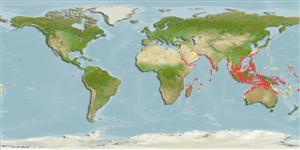Common names from other countries
>
Clupeiformes (Herrings) >
Dorosomatidae (Gizzard shads and sardinellas)
Etymology: Amblygaster: Greek, amblys = darkness + Greek, gaster = stomach (Ref. 45335).
More on author: Walbaum.
Environment: milieu / climate zone / depth range / distribution range
นิเวศวิทยา
เกี่ยวกับทะเล,น้ำเค็ม; กร่อย เกี่ยวกับหินโสโครก; ระดับความลึก 10 - 75 m (Ref. 12260). Tropical; 35°N - 28°S, 31°E - 178°W (Ref. 188)
Indo-West Pacific: Red Sea and Mozambique to the Philippines, north to Taiwan and Okinawa (Japan), south to New Guinea, the Arafura Sea (Ref. 9819), northern Australia, and Fiji.
Length at first maturity / ขนาด / น้ำหนัก / Age
Maturity: Lm 15.0 range ? - ? cm
Max length : 27.0 cm SL เพศผู้/กระเทย; (Ref. 54980); common length : 20.0 cm SL เพศผู้/กระเทย; (Ref. 188); อายุสูงสุดที่ได้รายงาน: 8 ปี (Ref. 1488)
เงี่ยงครีบหลัง (รวม) : 0; ก้านครีบอ่อนที่หาง (รวม) : 13 - 21; เงี่ยงครีบก้น: 0; ก้านครีบอ่อนที่ก้น: 12 - 23. Diagnosis: Body slender, belly rather rounded, scutes not prominent (Ref. 188). It is distinguished from Amblygaster clupeoides and A. leiogaster by the presence of a series of 10-20 gold, in life, or black, on preservation, spots down the flank, but sometimes missing; also, lower gillrakers 33-43, while 26-33 in the other two species (Ref. 188). Sardinops species are also round-bodied and have spots on the flanks, but possess bony radiating striae on the gill cover; round-bodied Sardinella species have one unbranched and 8 branched pelvic finrays while Amblygaster sirm has one unbranched and 7 branched pelvic finrays, and more than 100 gillrakers are present in Sardinella species, also no spots (Ref. 188). Last 2 anal-fin rays enlarged (Ref. 117228).
A pelagic, schooling species occurring in coastal waters and lagoons (Ref. 188, 53568), at depths of 1-75m (Ref. 82332). In Panggang Island, Indonesia it was recorded in temperatures of 28.5-29.8°C and salinities of 31.6-32.3 ppt (Ref. 823). It feeds mainly on copepods, nauplii and zoea larvae, larval bivalves and gastropods, as well as Peridinium and Ceratium; juveniles also on phytoplankton (Ref. 188). Used as bait in the tuna fishery.
Spawn in school (Ref. 205).
Whitehead, P.J.P., 1985. FAO Species Catalogue. Vol. 7. Clupeoid fishes of the world (suborder Clupeoidei). An annotated and illustrated catalogue of the herrings, sardines, pilchards, sprats, shads, anchovies and wolf-herrings. FAO Fish. Synop. 125(7/1):1-303. Rome: FAO. (Ref. 188)
IUCN Red List Status (Ref. 130435)
CITES (Ref. 128078)
Not Evaluated
Threat to humans
Harmless
Human uses
การประมง: การค้า; เหยื่อ: usually
เครื่องมือ
Special reports
Download XML
แหล่งที่มาจากอินเตอร์เน็ต
Estimates based on models
Preferred temperature (Ref.
115969): 26.2 - 29.1, mean 28.2 (based on 1152 cells).
Phylogenetic diversity index (Ref.
82804): PD
50 = 0.5625 [Uniqueness, from 0.5 = low to 2.0 = high].
Bayesian length-weight: a=0.00851 (0.00738 - 0.00981), b=3.04 (3.00 - 3.08), in cm Total Length, based on LWR estimates for this species (Ref.
93245).
ระดับชั้นอาหาร (Ref.
69278): 2.9 ±0.30 se; based on food items.
ความสามารถในการกลับคืนสู่ปกติ (Ref.
120179): ความสูง, เวลาต่ำสุดที่จะทำให้ประชากรเพิ่มขึ้นเป็น 2 เท่าใช้เวลาน้อยกว่า 15 เดือน (K=0.37-3.74; tm=1; tmax=8; Fec > 10,000).
Fishing Vulnerability (Ref.
59153): Low vulnerability (16 of 100).
